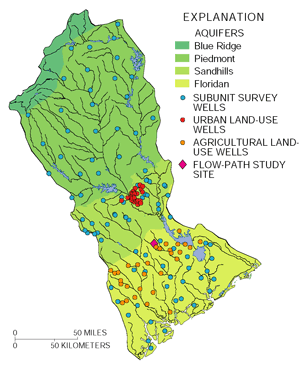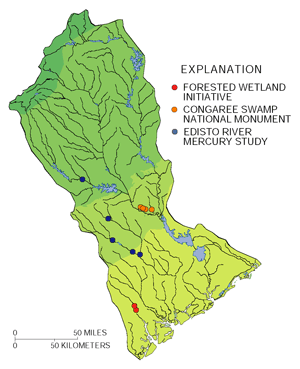STUDY UNIT DESIGN
| STREAM CHEMISTRY AND BIOLOGY Fixed sites were sampled to examine differences in streamwater quality due to the environmental setting, a combination of land use, geology, physiography, and climate. Intensive fixed sites were a subset of fixed sites that were sampled more frequently to determine the occurrence and seasonal variability of pesticides. Aquatic community structure, including algae, fish, and macroinvertebrates, was studied at each fixed site to quantify the effects of water quality on stream biota. Synoptic studies focused on low streamflow conditions in an urban setting in Gills Creek, S.C., and a mixed land-use setting in the South Fork Catawba River Basin, N.C. Streambed sediments and fish and clam tissues were sampled to determine the occurrence and distribution of trace elements and organic compounds. |
 |
 |
GROUND-WATER CHEMISTRY Subunit surveys were conducted in three drinking-water supply aquifers to assess overall water quality. Land-use studies in urban and agricultural settings evaluated the effects of these land uses on shallow ground water. An agricultural flow-path study examined the transport and fate of nutrients and pesticides in shallow ground water.
|
| SPECIAL STUDIES The effects of a forested wetland on nutrient concentrations in stream water were studied as part of the Forested Wetland Initiative, a joint research project with the U.S. Forest Service. Baseline data on water quality and aquatic communities were collected in cooperation with the National Park Service at Congaree Swamp National Monument (Maluk and Abrahamsen, 1999). A study to determine the accumulation of mercury in fish tissues was conducted in the Edisto River Basin. |
 |
| SUMMARY OF DATA COLLECTION IN THE SANTEE RIVER BASIN AND COASTAL DRAINAGES, 1995-98 |
||||
| Study component |
What data were collected and why |
Types of sites sampled |
Number of sites |
Sampling frequency and period |
|---|---|---|---|---|
| Stream Chemistry and Biology |
||||
| Fixed sites |
Streamflow was measured continuously and samples were collected monthly for major ions, nutrients, organic carbon, suspended sediment, bacteria, pesticides, and physical properties to describe concentration, seasonal variability, and loads. |
Streams draining basins ranging in size from 14 to 7,850 square miles and representing forested, agricultural, urban, and mixed land uses. |
13 |
Monthly, plus 3-6 storms (October 1995-September 1997) |
| Intensive fixed sites |
In addition to the above constituents, samples were analyzed for dissolved pesticides to describe concentration and seasonal variability. |
A subset of fixed sites draining agricultural, urban, and mixed land uses. |
3 |
Weekly during growing season (February 1996-October 1997) |
| Urban synoptic study |
Streamflow, major ions, nutrients, organic carbon, suspended sediment, bacteria, pesticides, volatile organic compounds, and physical properties were determined under low-flow conditions to describe concentrations and spatial distributions. |
Urban streams draining basins ranging in size from 0.5 to 59.4 square miles.
|
16
|
September 1996
|
| South Fork Catawba River synoptic study |
Streamflow, major ions, nutrients, organic carbon, suspended sediment, bacteria, and physical properties were determined under low-flow conditions to describe concentrations and spatial distributions. |
Mixed land use streams draining basins ranging in size from 5 to 350 square miles. |
20
|
October 1997 |
| Streambed sediments |
Streambed sediments were analyzed for trace elements and hydrophobic pesticides and other organic compounds to determine occurrence and spatial distribution. |
Sediment depositional zones at all fixed sites and other selected sites. |
20 |
Summer 1995 |
| Aquatic biota |
Clams and fish livers were analyzed for trace metals, and clams and whole fish were analyzed for organic compounds to determine occurrence and spatial distribution. |
All fixed sites and other selected sites. |
20 |
Summers 1995, 1996 |
| Fixed site reach assessment
|
Fish, benthic invertebrates, algae, and aquatic and riparian habitats were sampled and described to assess aquatic biological community structure in different land uses and associated habitats. |
Stream reaches located at or near fixed sites. Sites represent the variety of land uses, geology, and physiography within the Santee Basin |
13
|
Once in 1996 or 1997; Multiyear sites, once during 1996-98 |
| Ground-Water Chemistry |
||||
| Study unit survey |
Major ions, nutrients, pesticides, volatile organic compounds, dissolved organic carbon, trace metals, radon and physical parameters analyzed in three major drinking-water aquifers to determine ground-water quality. |
Randomly
chosen existing pubic supply, private domestic, irrigation, and
industrial supply wells in the Piedmont, |
90 (30 per aquifer) |
Sandhills--Summer 1996 |
| Urban land-use study |
Major ions, nutrients, pesticides, volatile organic compounds, dissolved organic carbon, and physical parameters analyzed in shallow ground water in the Columbia, South Carolina, metropolitan area. |
Wells installed at randomly chosen commercial/residential land-use areas. |
30 |
Summer 1996 |
| Agricultural land-use study |
Major ions, nutrients, pesticides, dissolved organic carbon, and physical parameters analyzed in shallow ground water in row-crop agricultural lands of the lower Coastal Plain |
Wells installed at randomly chosen row-crop land-use areas. |
30
|
Summer 1997 |
| Flow-path study |
Major ions, nutrients, pesticides, dissolved organic carbon, and physical parameters analyzed to determine fate and transport of pesticides and nutrients in an agricultural setting. |
Multidepth wells installed along a ground-water flow path in the lower Coastal Plain. |
34 |
November 1997, April and August 1998 |
| Special Studies |
||||
| Forested Wetland Initiative |
Major ions, nutrients, and organic carbon analyzed upstream and downstream from a forested wetland to compare changes in concentrations. |
Coosawhatchie River in the lower Coastal Plain. |
2 |
Approximately quarterly, 1996-97 |
| Congaree Swamp National Monument |
Streamflow, major ions, nutrients, organic carbon, suspended sediment, bacteria, pesticides, and physical properties to describe concentrations and seasonal variability. Fish, benthic invertebrates, algae, and aquatic habitat described to assess aquatic biological community structure. |
Streams draining basins ranging in size from 32 to 70 square miles with agricultural, urban, and forested land uses that drain into Congaree Swamp. |
4 |
Quarterly 1996-98 |
| Edisto mercury study |
Sediment, stream water, aquatic insects, and vegetation, and whole fish analyzed for elemental and methyl mercury to examine bioaccumulation of mercury. |
Blackwater streams in the Edisto River Basin and a reference site in the Piedmont |
5 |
Once in 1998 |
| Table of Contents || Previous Section || Next Section || Glossary U.S. Geological Survey Circular 1206 Suggested citation:
|
